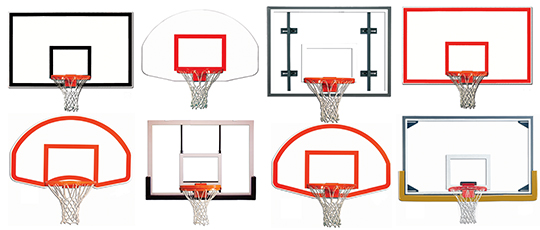Basketball backboards have come a long way from the wood boards originally used for the game at the turn of the century. Now facilities and consumers have a wider variety than ever before of materials and sizes to choose from in the marketplace, depending on budget, play level, and play environment. Let’s look at the pros and cons to each type so you can make an informed decision before you purchase.
Material
GLASS BACKBOARDS are the most popular style used in schools and recreational facilities because glass delivers the best rebound, sound, and overall playability. In fact, NCAA schools and professional teams require glass boards for high levels of competition play. However, glass boards are the most expensive of all the board types, and outdoor courts in vandal-prone areas should consider a more durable alternative, such as steel.
STEEL BOARDS have become the preferred choice for outdoor courts, heavy play settings, and urban areas due to their superior strength and durability over other board types. In addition, steel boards are offered as fan-shaped and rectangular, giving facilities more options for the look of their courts.
ALUMINUM BOARDS are generally considered rust-proof (unlike steel), and their lightweight durability makes them sought-after for outdoor use.
FIBERGLASS BOARDS are also lightweight and deliver a superior rebound to other materials, making them a versatile board choice for indoor or outdoor applications.
ACRYLIC BOARDS are a popular indoor and outdoor option because they are lightweight, economical, stronger than glass, and are typically offered in several rectangular sizes, but they can get cloudy or develop a yellowish color over time when used outside.
POLYCARBONATE BOARDS are extremely heavy-duty and can stand up to even the roughest play. These boards are often touted as “bulletproof”, thus making them a smart choice for playground courts that are susceptible to vandalism, although they are the most expensive of all the outdoor board types.
Finish
Most non-clear backboards used for outdoor settings will be powdercoated white to protect the board from harsh weather elements, such as moisture and UV exposure. If budget allows, you may want to consider upgrading to a board with an optional orange rectangular target to provide a clear visual for players when making a shot. On some boards, the target will include an orange border around the perimeter of the board as well, to provide visual distinction between the backboard and whatever is behind the unit. Although an orange target and border are the norm in the United States, some countries around the world prefer a black target and border on their backboards. Clear boards such as glass, acrylic, or polycarbonate will always include a white rectangular target as standard.
Size and Shape
In addition to the backboard material, you will also want to consider the size and shape of the board. A regulation size 42” x 72” board is required for NCAA and professional play levels, and is generally the most popular board size for main court use and heavy play settings. On the other hand, fan-shape boards are a good choice for younger players, recreational facilities, or programs on a tight budget. The National Federation of State High School Associations (NFHS) official rules also allows fan-shape boards to be used for high school competition play. Smaller rectangular board sizes, such as 36” x 48”, 34” x 54”, or 42” x 60”, may be considered for side court use, smaller facilities, and residential use. Facilities that are thinking of upgrading from fan-shape boards to rectangular boards can make the switch with versatile conversion backboards that allow rectangular boards to be placed on fan mounting centers without the expense of replacing the entire backstop structure.

